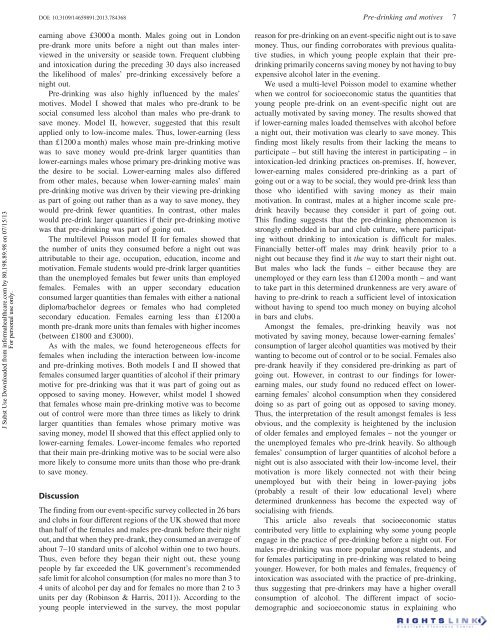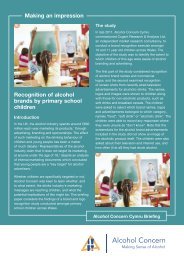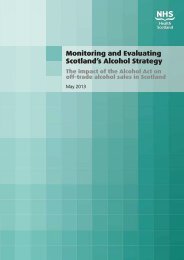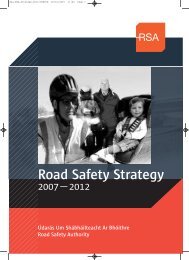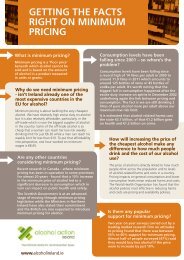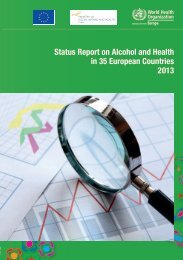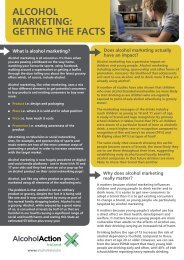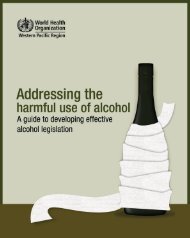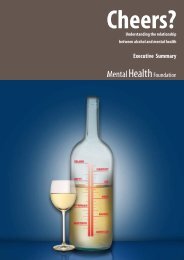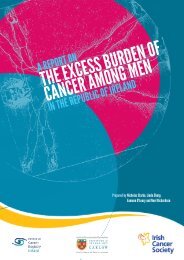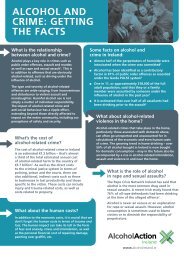Who pre-drinks before a night out and why? - Alcohol Action Ireland
Who pre-drinks before a night out and why? - Alcohol Action Ireland
Who pre-drinks before a night out and why? - Alcohol Action Ireland
You also want an ePaper? Increase the reach of your titles
YUMPU automatically turns print PDFs into web optimized ePapers that Google loves.
DOI: 10.3109/14659891.2013.784368 Pre-drinking <strong>and</strong> motives 7J Subst Use Downloaded from informahealthcare.com by 80.198.89.98 on 07/15/13For personal use only.earning above £3000 a month. Males going <strong>out</strong> in London<strong>pre</strong>-drank more units <strong>before</strong> a <strong>night</strong> <strong>out</strong> than males interviewedin the university or seaside town. Frequent clubbing<strong>and</strong> intoxication during the <strong>pre</strong>ceding 30 days also increasedthe likelihood of males’ <strong>pre</strong>-drinking excessively <strong>before</strong> a<strong>night</strong> <strong>out</strong>.Pre-drinking was also highly influenced by the males’motives. Model I showed that males who <strong>pre</strong>-drank to besocial consumed less alcohol than males who <strong>pre</strong>-drank tosave money. Model II, however, suggested that this resultapplied only to low-income males. Thus, lower-earning (lessthan £1200 a month) males whose main <strong>pre</strong>-drinking motivewas to save money would <strong>pre</strong>-drink larger quantities thanlower-earnings males whose primary <strong>pre</strong>-drinking motive wasthe desire to be social. Lower-earning males also differedfrom other males, because when lower-earning males’ main<strong>pre</strong>-drinking motive was driven by their viewing <strong>pre</strong>-drinkingas part of going <strong>out</strong> rather than as a way to save money, theywould <strong>pre</strong>-drink fewer quantities. In contrast, other maleswould <strong>pre</strong>-drink larger quantities if their <strong>pre</strong>-drinking motivewas that <strong>pre</strong>-drinking was part of going <strong>out</strong>.The multilevel Poisson model II for females showed thatthe number of units they consumed <strong>before</strong> a <strong>night</strong> <strong>out</strong> wasattributable to their age, occupation, education, income <strong>and</strong>motivation. Female students would <strong>pre</strong>-drink larger quantitiesthan the unemployed females but fewer units than employedfemales. Females with an upper secondary educationconsumed larger quantities than females with either a nationaldiploma/bachelor degrees or females who had completedsecondary education. Females earning less than £1200 amonth <strong>pre</strong>-drank more units than females with higher incomes(between £1800 <strong>and</strong> £3000).As with the males, we found heterogeneous effects forfemales when including the interaction between low-income<strong>and</strong> <strong>pre</strong>-drinking motives. Both models I <strong>and</strong> II showed thatfemales consumed larger quantities of alcohol if their primarymotive for <strong>pre</strong>-drinking was that it was part of going <strong>out</strong> asopposed to saving money. However, whilst model I showedthat females whose main <strong>pre</strong>-drinking motive was to become<strong>out</strong> of control were more than three times as likely to drinklarger quantities than females whose primary motive wassaving money, model II showed that this effect applied only tolower-earning females. Lower-income females who reportedthat their main <strong>pre</strong>-drinking motive was to be social were alsomore likely to consume more units than those who <strong>pre</strong>-drankto save money.DiscussionThe finding from our event-specific survey collected in 26 bars<strong>and</strong> clubs in four different regions of the UK showed that morethan half of the females <strong>and</strong> males <strong>pre</strong>-drank <strong>before</strong> their <strong>night</strong><strong>out</strong>, <strong>and</strong> that when they <strong>pre</strong>-drank, they consumed an average ofab<strong>out</strong> 7–10 st<strong>and</strong>ard units of alcohol within one to two hours.Thus, even <strong>before</strong> they began their <strong>night</strong> <strong>out</strong>, these youngpeople by far exceeded the UK government’s recommendedsafe limit for alcohol consumption (for males no more than 3 to4 units of alcohol per day <strong>and</strong> for females no more than 2 to 3units per day (Robinson & Harris, 2011)). According to theyoung people interviewed in the survey, the most popularreason for <strong>pre</strong>-drinking on an event-specific <strong>night</strong> <strong>out</strong> is to savemoney. Thus, our finding corroborates with <strong>pre</strong>vious qualitativestudies, in which young people explain that their <strong>pre</strong>drinkingprimarily concerns saving money by not having to buyexpensive alcohol later in the evening.We used a multi-level Poisson model to examine whetherwhen we control for socioeconomic status the quantities thatyoung people <strong>pre</strong>-drink on an event-specific <strong>night</strong> <strong>out</strong> areactually motivated by saving money. The results showed thatif lower-earning males loaded themselves with alcohol <strong>before</strong>a <strong>night</strong> <strong>out</strong>, their motivation was clearly to save money. Thisfinding most likely results from their lacking the means toparticipate – but still having the interest in participating – inintoxication-led drinking practices on-<strong>pre</strong>mises. If, however,lower-earning males considered <strong>pre</strong>-drinking as a part ofgoing <strong>out</strong> or a way to be social, they would <strong>pre</strong>-drink less thanthose who identified with saving money as their mainmotivation. In contrast, males at a higher income scale <strong>pre</strong>drinkheavily because they consider it part of going <strong>out</strong>.This finding suggests that the <strong>pre</strong>-drinking phenomenon isstrongly embedded in bar <strong>and</strong> club culture, where participatingwith<strong>out</strong> drinking to intoxication is difficult for males.Financially better-off males may drink heavily prior to a<strong>night</strong> <strong>out</strong> because they find it the way to start their <strong>night</strong> <strong>out</strong>.But males who lack the funds – either because they areunemployed or they earn less than £1200 a month – <strong>and</strong> wantto take part in this determined drunkenness are very aware ofhaving to <strong>pre</strong>-drink to reach a sufficient level of intoxicationwith<strong>out</strong> having to spend too much money on buying alcoholin bars <strong>and</strong> clubs.Amongst the females, <strong>pre</strong>-drinking heavily was notmotivated by saving money, because lower-earning females’consumption of larger alcohol quantities was motived by theirwanting to become <strong>out</strong> of control or to be social. Females also<strong>pre</strong>-drank heavily if they considered <strong>pre</strong>-drinking as part ofgoing <strong>out</strong>. However, in contrast to our findings for lowerearningmales, our study found no reduced effect on lowerearningfemales’ alcohol consumption when they considereddoing so as part of going <strong>out</strong> as opposed to saving money.Thus, the inter<strong>pre</strong>tation of the result amongst females is lessobvious, <strong>and</strong> the complexity is heightened by the inclusionof older females <strong>and</strong> employed females – not the younger orthe unemployed females who <strong>pre</strong>-drink heavily. So althoughfemales’ consumption of larger quantities of alcohol <strong>before</strong> a<strong>night</strong> <strong>out</strong> is also associated with their low-income level, theirmotivation is more likely connected not with their beingunemployed but with their being in lower-paying jobs(probably a result of their low educational level) wheredetermined drunkenness has become the expected way ofsocialising with friends.This article also reveals that socioeconomic statuscontributed very little to explaining <strong>why</strong> some young peopleengage in the practice of <strong>pre</strong>-drinking <strong>before</strong> a <strong>night</strong> <strong>out</strong>. Formales <strong>pre</strong>-drinking was more popular amongst students, <strong>and</strong>for females participating in <strong>pre</strong>-drinking was related to beingyounger. However, for both males <strong>and</strong> females, frequency ofintoxication was associated with the practice of <strong>pre</strong>-drinking,thus suggesting that <strong>pre</strong>-drinkers may have a higher overallconsumption of alcohol. The different impact of sociodemographic<strong>and</strong> socioeconomic status in explaining who


